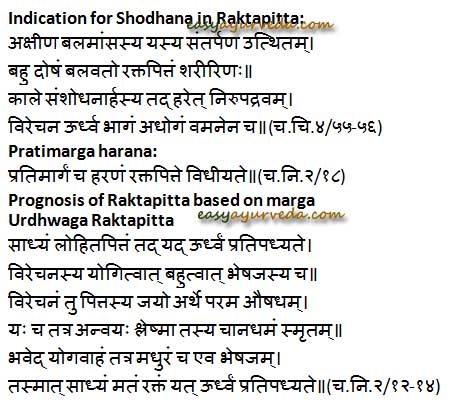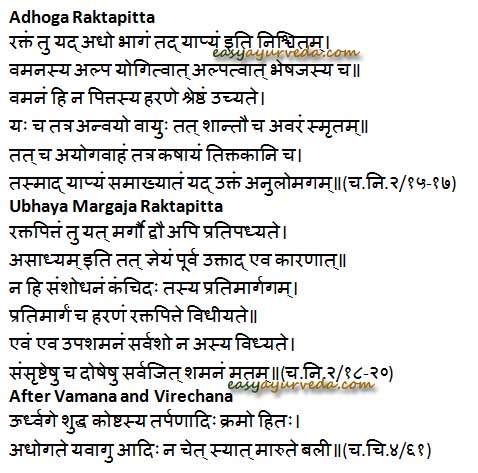Panchakarma and Pratimarga Harana Chikitsa in Raktapitta
Article by Dr Raghuram Y.S. MD (Ay) & Dr Manasa, B.A.M.S
Panchakarma and Pratimarga Harana Chikitsa are important strategies in the treatment of Raktapitta.
Panchakarma –
5 cleansing treatments i.e. Vamana (therapeutic emesis), Virechana (therapeutic purgation), Asthapana Vasti (decoction enemas), Anuvasana Vasti (herbal oil enemas) and Nasya (nasal medication)
Read related: Ayurvedic Panchakarma Treatment: simple explanation for easy understanding

Pratimarga Harana Chikitsa –
Prati = Opposite, Marga = Route, Harana = Elimination or expulsion, Chikitsa = Treatment
Pratimarga Harana Chikitsa means treatments in which the doshas are expelled in the opposite routes of their manifestation
Table of Contents
Panchakarma in Raktapitta
Utility of Panchakarma with special reference to Vamana and Virechana in the treatment of Raktapitta
Panchakarma comprises of 5 body cleansing and detoxifying treatments of Ayurveda which help in cleansing the body of the toxicity caused by morbid doshas and visha. They help in expelling the morbid doshas, visha (toxins) and mala (waste substances in the body), hence take part in cleansing the cells and channels in the body. With this, the circulation of nutrients and essential things will be re-established and the metabolism comes back to normal. Panchakarma helps in comprehensively curing the body of its ailments and also in preventing their recurrences. They provide strength to the body and helps in boosting immunity.
Raktapitta is caused by morbid combination of vitiated pitta and rakta which are contaminating the body and causing various complications. The severe bleeding occurring from various orifices leads to weakness and other symptoms. The association of ama (unprocessed nutritional juices in circulation, formed due to sluggish digestion) in the disease further increases the quantity of morbid pitta and morbid rakta and worsen the bleeding. If the morbidity caused by Raktapitta needs to be controlled, the ama and vitiated pitta needs to be expelled from the body. Along with this the kapha associated with pitta in urdhwaga raktapitta and vitiated vata associated with pitta in adhoga raktapitta too needs to be taken into control.
Panchakarma, especially Vamana (therapeutic emesis or medicine induced vomiting) and Virechana (therapeutic purgation or medicine induced purging) are highly beneficial in expelling the morbid doshas in Raktapitta.
Note –
- Urdhwaga Raktapitta = Raktapitta having upward course, bleeding occurs from nose, ears, eyes and mouth
- Adhoga Raktapitta = Raktapitta having downward course, bleeding occurs from anus, urinary passages and vagina
Since vitiated Pitta and vitiated rakta (blood) form a vicious combination in Raktapitta, if the morbid Pitta and associated Kapha or Vata are controlled after administering Vamana and Virechana, the bleeding in Raktapitta also comes into control. On the contrary if the morbid doshas are left unattended, the bleeding of vitiated blood keeps worsening leading to severe complications.
Conditions indicated for shodhana
Conditions for administering Shodhana (Panchakarma) in Raktapitta
Shodhana or Panchakarma measures which are highly beneficial in the treatment of Raktapitta chiefly comprises of Vamana (therapeutic emesis) and Virechana (therapeutic purgation). The conditions for administering Vamana and or Virechana (Shodhana) are as below mentioned –
- Aksheena Bala – The bala or strength (endurance, tolerance capacity) of the patient should not have been compromised, i.e. the strength of the patient should not have reduced (should be intact)
- Aksheena Mamsa – The mamas or bulk of muscles (good muscle mass or bulk suggests good health and immunity) of the patient should not have been compromised, i.e. the muscle bulk and strength of the patient should not have reduced (should be intact)
- Santarpanotthitam – The Raktapitta should have been caused by santarpana or over-saturation
- Bahu Dosha – The doshas should be present in excessive quantity
- Balavato Shareerinam – The patient should have a good physical built which in turn indicates good health and proper balance of tissues (dhatu samya)
- Samshodhana arha – The patient should be fit to undergo Shodhana or cleansing treatments, Vamana and Virechan in this instance
- Nirupadravam – Raktapitta should be devoid of complications
In the presence of the above said conditions, Doshas should be eliminated through Vamana and or Virechana following the rule of Pratimarga Harana i.e. Virechana should be administered in Urdhwaga Raktapitta and Vamana should be administered in Adhoga Raktapitta

Pratimarga Harana
Utility of Prati Marga Harana Chikitsa with special reference to Vamana and Virechana in the treatment of Raktapitta
Prati = Opposite
Marga = Direction
Harana = Elimination
Pratimarga Harana is a unique and special method of treatment used in Raktapitta management. In this the treatment is administered in the route or direction opposite to that of bleeding.
In Raktapitta, the bleeding occurs in two directions i.e.
In upper directions or from upper passages (openings) including nostrils, ears, eyes and mouth, this condition is called Urdhwaga Raktapitta
In lower directions or from lower passages (openings) including anus, urinary passage (urethra) and vagina (birth passage in women), this condition is called Adhoga Raktapitta
Generally in any disease, the morbid doshas are expelled from the nearest route or in the same direction in which they are flowing, enabling their easy expulsion. This means to tell that when the doshas are having an upward course (direction), Vamana or therapeutic emesis is administered. Vamana occurs in the same direction as the movement or flow of morbid doshas. Similarly when the doshas are having a downward course (direction), Virechana or therapeutic purgation is administered. Virechana occurs in the same direction as the movement or flow of morbid doshas.
But in the Pratimarga Harana Chikitsa administered in Raktapitta, Virechana or purgation is given when the dosha pravritti (movement of blood contaminated with pitta) is in upward direction (Urdhwaga Raktapitta) and Vamana or emesis is administered when the dosha pravritti is in downward direction. This means to tell that the treatment is given in an opposite direction as that of the direction or course of morbid rakta.
Why should Pratimarga Harana Chikitsa be given in Raktapitta? (Mode of action of Pratimarga Harana)
The bleeding is occurring from upward passages (orifices) in Urdhwaga Raktapitta. In this case, if Vamana is administered (keeping in view the direction of flow of doshas as done in other diseases), it will further worsen the condition and cause more bleeding leading to life threatening complications or death itself. Therefore Virechana should be administered in Urdhwaga Raktapitta. Virechana will have a downward pull, natural for it. Due to the suction caused by Virechana and its disease modifying effect, Virechana will pull down the gati (upward movement of doshas) of doshas and thus will control bleeding.
The bleeding is occurring from downward passages (orifices) in Adhoga Raktapitta. In this case, if Virechana is administered (keeping in view the direction of flow of doshas as done in other diseases), it will further worsen the condition and cause more bleeding leading to life threatening complications or death itself. Therefore Vamana should be administered in Adhoga Raktapitta. Vamana will have an upward pull, natural for it. Due to the suction caused by Vamana and its disease modifying effect, Vamana will cause an upward pull (upward movement of doshas) of doshas and thus will control bleeding.
Saadhya Asaadhyata (prognosis) of Raktapitta based on the marga or route of the disease (bleeding) with Pratimarga Harana perspective
Urdhwaga Raktapitta
Urdhwaga Raktapitta is considered to be Saadhya (easily curable) since it can be treated by administering Virechana (Virechana is well tolerated in comparison to Vamana, since Vamana occurs closer to or towards heart, lungs and head). Also there are wide options of medicines and herbs which are used for Virechana (purgative and laxative herbs), in comparison to the Vamaka Dravyas (emetic herbs or medicines used to induce vomiting). Virechana is anti-pitta (pitta nashaka). In Urdhwaga Raktapitta, kapha is associated with Pitta and Virechana also destroys kapha. Thus Virechana combats both main morbid dosha (pitta) and associated dosha (kapha). With Virechana, once Kapha is expelled or destroyed, the administration of medicines predominant in Kashaya (astringent), Tikta (bitter) and Madhura (sweet) Rasas (tastes) are helpful in combating both pitta and kapha. Therefore Urdhwaga Raktapitta can be cured with ease.
Adhoga Raktapitta
Adhoga Raktapitta is considered to be Yapya (manageable) since its treatment is Vamana, which is less tolerant in comparison to Virechana. Also there are too less options of medicines and herbs which are used for Vamana (emetic herbs), in comparison to the Virechaka Dravyas (purgative herbs used to cause purgation, laxatives, purgatives). In Adhoga Raktapitta, there is association of Vata along with Pitta. Vamana is neither a choice remedy for the main morbid dosha (pitta) nor the associated dosha (vata). The Kashaya and Tikta Rasas (or medicines and herbs predominant in astringent and bitter tastes) which are antagonistic to pitta (pitta nashaka) are Vata increasing (vata prakopaka) in nature. If the Vata increases it causes severe bleeding from lower orifices of the body leading to life taking complications or death itself. Therefore Adhoga Raktapitta cannot be easily cured; in fact it can be managed with timely approach, proper diagnosis and effective medications.
Ubhaya Margaja Raktapitta
Ubhaya Margaja Raktapitta (Raktapitta in which bleeding occurs in both upward and downward directions, i.e. upper and lower orifices of the body) is said to be asaadhya (incurable) because neither Vamana nor Virechana could be effectively administered in this condition in which there is bi-way bleeding. Also there are no medicines or herbs which can destroy all the 3 morbid doshas (all 3 doshas are involved in Ubhaya margaja Raktapitta). Since there is heavy blood loss in both directions, the condition itself is an emergency and carries worst prognosis.
Virechana in Raktapitta
Choice of Virechana in Raktapitta
The below mentioned herbs are said to be the best for Virechana in Urdhwaga Raktapitta.
- Trivrit Haritaki Churna – The combination of powders of Trivrit (Operculina turpethum) and Haritaki (Terminalia chebula)
- Aragwadha Phala Majja – Fruit pulp of Aragwadha (Cassia fistula)
- Trayamana Mula – Root of Trayamana (Gentiana kurroo)
- Gavakshi Mula – Root of Gavakshi (Citrullus colocynthis)
- Amalaka Mula – Roots of Amalaki (Emblica officinalis)
Preferably the juice of any one of the above said should be mixed with abundant quantities of Madhu (honey) and Sharkara (sugar) should be given. Mamsarasa (meat soup) of Paravata (pigeon) etc should be provided as diet while administering Virechana.
Vamana in Raktapitta
Choice of Vamana in Raktapitta
The Mantha (churned drink) mixed with Madanaphala Churna (powder of Randia dumetorum) added with Madhu (honey) and Sharkara (sugar) should be administered for Vamana. Before administering this compound Sharkara jala (sugared water) or Ikshu Rasa (sugarcane juice) should be given to drink stomach-full.
Alternatively the powders of (juices of) Indrayava (seeds of Holarrhena antidysenterica), Musta (Cyperus rotundus), Madana (Randia dumetorum) and Madhuka (Licorice) mixed together and used as an emetic after mixing sufficient amount of honey.
After Vamana and Virechana
After administering Virechana in Urdhwaga Raktapitta, Tarpana (nourishing drinks and food) should be given.
After administering Vamana in Adhoga Raktapitta, Yavagu (gruels) should be given. If Vata is predominant in Adhoga Raktapitta, Mamsarasa (meat-soup) should be given in place of Yavagu.
Just Before Finishing
The utility of Panchakarma is well known as long as effective cure of almost diseases is concerned. But in Raktapitta, which is a life threatening bleeding disorder, Panchakarma, especially Vamana and Virechana cannot be administered in a regular and classical way. This article touches upon the skilful administration of Panchakarma and proper understanding of Pratimarga Harana Chikitsa which is a key treatment strategy in effective cure of Raktapitta.
Click to Consult Dr Raghuram Y.S. MD (Ayu)









